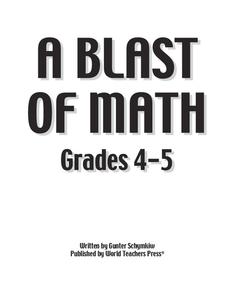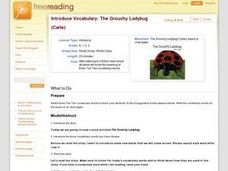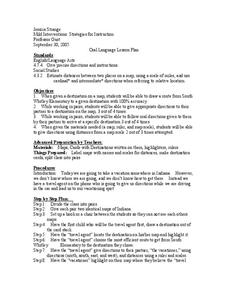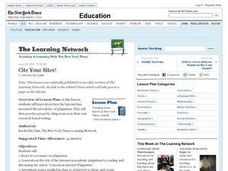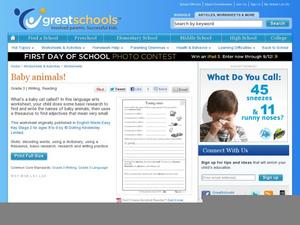Roald Dahl
The Twits - Mrs Twit
"A person who has good thoughts cannot ever be ugly." The second lesson in an 11-part unit that accompanies The Twits by Roald Dahl uses poetry to encourage positive character traits. Mrs. Twit has ugly thoughts, but those thoughts can...
Curated OER
What They Left Behind: Early Multi-National Influences in the United States
Learners research the impact of European voyages of discovery and colonial influence on different aspects of American culture. They access a number of online sources and reference maps to trace the influences of England, France, Holland,...
Curated OER
Children Around The World
Learners read a multicultural book called "This Is the Way We Go to School" by Edith Baer and Steve Bjorhman. They become culturally aware of the different nationalities around the world and different ways that they may do things on a...
Curated OER
A Blast of Math
In this metric measurement worksheet, students solve 20 fill in the blank questions related to metric measurement, converting metric units, area of rectangles, picture graphs, patterns, geometric shapes. Students then convert 9...
Curated OER
Real-Life Problems, Working with Decimals #2
It's all about decimals in these word problems, which have scholars apply math to scenarios they will likely come across later in life. Working with multi-digit numbers and decimals to the hundredths place, learners must determine the...
EngageNY
Grade 9 ELA Module 1, Unit 1, Lesson 3
Just like in real life, characters in short stories show their true personalities through their words and deeds. Decipher the character development in Karen Russell's "St. Lucy's Home for Girls Raised by Wolves" with a set of activities...
Frank Macias Elementary School
Preparing for Guided Reading
Take your guided reading lesson plans to the next level with a collection of printables, templates, and reference tools equipped to support the reading needs of your readers. Included is a detailed information page, grouping sheet,...
Soft Schools
Plot — 3rd or 4th Grade
After reading a version of "The Tortoise and the Hare," scholars complete a plot diagram. They pinpoint the tale's beginning, rising action, climax, falling action, and ending.
Curated OER
Insect Book
Fifth graders select an insect and create a page for an Insect ABC book to display their research. They choose an insect from a given letter of the alphabet and use KidPix to illustrate. They write 2-3 sentences describing their insect...
Curated OER
Doing Dewey
Young scholars discuss the Dewey Decimal Classification System and how it works. They organize ten books according to the Dewey Decimal Classification System.
Curated OER
Glossary, Index, and Table of Contents
Fourth graders use two separate sources to learn about index, glossary, and table of contents usage. In this library lesson plan, 4th graders use two books, Learning About Weather with Graphic Organizers, and The World Almanac for Kids,...
Curated OER
Introduce Vocabulary: The Grouchy Ladybug
Learners explore language arts by reading a children's book in class. In this vocabulary identification lesson, students read the book The Grouchy Ladybug and answer study questions about the story. Learners define a list of vocabulary...
Curated OER
Snowflake Bentley
Students read books and draw pictures about what a scientist does. In this scientist lesson plan, students brainstorm together of all the things a scientist does.
Alabama Learning Exchange
Welcome to our Classroom
Second graders create a classroom resource book for substitutes to help them feel more comfortable and familiar with faces and procedures in our classroom and school. They develop skill in using a digital camera and computer technology.
Curated OER
Identifying the Solution in a Story
Using the book My Red Balloon by Eve Bunting, Kindergartners will gain an understanding that stories often have solutions. Using Eve Bunting's book as an example the teacher will identify the solution to the story and walk the students...
Curated OER
Introduce Vocabulary: Into the A, B, Sea
Students explore language arts by reading a classic book in class. For this story vocabulary lesson, students read the book Into the A, B, Sea and identify the use of specific vocabulary words. Students define the story vocabulary words...
Curated OER
Penguins
Students read books, learn about the letter p, and eat goldfish crackers all to learn about penguins. In this penguins lesson plan, students also color black and white pictures of penguins.
Curated OER
Storybook Art: Hands-On Art for Children
Learners are read "Harold and the Purple Crayon. Using the same technique, they draw their own one-line design but use various drawing techniques to do so. They measure the line and if time permits they draw other lines in different...
Curated OER
Introduce Vocabulary: Frida
Students explore language arts by reading a non-fiction story in class. In this three tiered vocabulary instructional activity, students read the book Frida and discuss the real life Frida and her story. Students identify vocabulary...
Curated OER
We're Going On A Leaf Hunt
Learners read the story We're Going on a Leaf Hunt and read companion stories, make leaves, work with rhyming and word families, and more. In this reading lesson plan, students take 5 days to read the book.
Curated OER
Introduce Vocabulary: Night Shift Daddy
Students explore language arts by reading a children's book in class. In this story vocabulary lesson, students read the book Night Shift Daddy and identify the use of specific vocabulary words. Students utilize the vocabulary terms to...
Curated OER
Oral Language
Students use distances on a map to draw a route, give directions, and follow directions. In this map lesson plan, students explain their route and directions orally.
Curated OER
Cite Your Sites
What information would you find in an almanac that you would not find in an atlas? What is the difference between a dictionary and a thesaurus? Using a Cite Your Sites worksheet on which they record their observations, groups participate...
Curated OER
Young Ones
This is the cutest reference materials activity ever! Researchers complete six sentences on baby animal names, continuing the pattern by writing five more sentences about other animals from their research. They use a thesaurus to look up...





